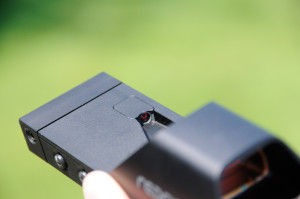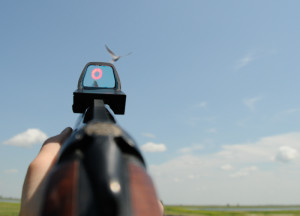Shotgun Sights
Shotgun sights have remained virtually unchanged since the first scatterguns – typically a brass bead, or more recently a fiber optic post sight. In order to get good at shooting a shotgun, most of us require considerable practice. Shooting with a shotgun is instinctive, more like pointing, quite different from the focused aiming one does with a rifle. While the front post aids in pointing the shotgun in the correct direction, the fit of the shotgun stock is more important. The fit ensures that every time the shotgun is mounted to your shoulder that it is in the same spot, and you learn through practice where to hold the gun. If a shotgun doesn’t fit you well, as is the case with many over-the-counter shotguns, you may never learn to shoot very well.
So where am I going with all this? A Swedish company (www.redringsight.com) has come up with what they think is the answer – an optical shotgun sight called the Redring®.
UPDATE – March 12, 2014
The following review is for the first generation Redring sight. New for 2014 Redring launched the Mk II sight. The Mk II boasts stronger electronics, a glass window instead of plastic, along with mounts to install the Mk II on any shotgun. A Picatinny rail adapter is also available for tactical shotguns. MSRP $599 – a price decrease from the original with several upgrades. Check it out at www.redringusa.com/shop
The Redring ®

The Specs
- Battery: AAAA 1.5V, Approx 300 h life. Redring® automatically shuts off after 4 hrs
- Weight: 134 g (4.726oz) excluding mounts, 192 g (6.773oz) including mounts
- Length: 134 mm (5.275in), mounts included
- Width: 44 mm (1.732in)
- Height: 45.7 mm (1.779in)
- Material: Anodized aluminum
Warranty: 5-year warranty on production defects. More details in the booklet’s Terms and Conditions.
The Redring® sight is easily mounted on any shotgun with a rib ranging from 5 mm – 11.5 mm. It comes with 3 different clamp/shim combinations allowing a precise fit on your shotgun. To install, simply select the correct mounts for your gun and tighten it down with a hex key included in the box. The mounting system has been specially designed not to damage the shotgun rib.
Externally it is similar in appearance to a red dot rifle or pistol sight. When looking through the sight, the target (a red ring, thus the name) is displayed. The sight itself has a number of innovative features. The brightness of the red ring automatically adjusts with changing light conditions – the brighter the background, the wider the ring. This is great for shotgunning, since tracking a moving target through the air can mean going from a dark to bright background in a single pass. A good example of this is goose hunting at sunrise.
Another benefit of using a Redring® sight over a conventional post is that it can be used for distance estimation. On the Redring® website they say the size of the target ring is equal to the shot diameter/burst at 20 meters. Although it is best to pattern each shotgun and load/choke combination that you plan on using for a true measure in your gun, comparing the size of the target in relation to the red ring will give you a good estimate of distance to target, or simply whether the target is within shooting distance or not. “Shoot” vs “don’t shoot” distance estimation can be used on all targets and game once you understand the relationship between the target and the effective pattern at your maximum range.
Now to the best part…the Redring® sight does not have parallax. What does this mean? What the shooter sees through the aiming ring is where the shotgun will hit in relation to the target. Now think back to the discussion on shotgun fit. While it is still best to have a shotgun that fits you in order to shoot your best, a parallax free aiming system will mean that no matter how the gun is mounted, if you can see the target through the sight and it is in range you should be able to hit it – the sighting system is not affected by eye dominance. The sight will enable the shooter to fire with both eyes open, allowing faster target identification and better target tracking. Exciting if you ask me.
 If you want to see how this really works, don’t just rely on my description! Try their handy on-line simulator.
If you want to see how this really works, don’t just rely on my description! Try their handy on-line simulator.
Field Test
So how did the Redring® fare in the field? Shooting with both eyes, one for tracking the target and the other to look through the sight took a little getting used to, but after a handful of rounds it started to feel quite natural on the shotgun. It is light and mounted relatively low, so it doesn’t noticeably change the balance of the shotgun. My day at the range was a comfortable 21°C, clear sky with a light breeze blowing from left to right – perfect conditions to test a new shotgun sight.
I specifically wanted to test the sight’s ease of use and most importantly if it improved my hit percentages.
I started out my session by throwing 25 clay targets without the sight attached. My lack of practice over the winter showed, as I hit 19/25 targets. I proceeded to mount the Redring® sight on my shotgun. I missed the first four targets while I got the hang of this new shooting system…. I connected on the fifth. I had been leading the target a bit too much. Once I got the hang of where to hold the red ring in relation to the moving target I started crushing the targets with ease. The most obvious thing that I noticed was that I was not just breaking them into a few pieces but was literally dusting them. I still missed a couple of more targets in the first round with the Redring® sight, but the hits were perfect and beautiful. After the first round with the Redring® sight my score was 19/25 – the same as my gun without the sight. As the cobwebs of winter started to clear, I would shoot another round – one with the Redring® and one without. Keeping the Redring® sight mounted I shot a 23/25 round followed by a 22/25 round with the sight removed. Not a definitive conclusion, so the final testing will come this fall on game birds.
Overall Impression
From the packaging to the fit and finish of the sight, you can immediately tell the Redring® is a well-made product. The quality is coupled with a number of innovative features, minimal maintenance and ease of mounting. These features come at a price. At the current time, the MSRP is $749USD.
This new sight will definitely find a home on top of my shotgun this fall. Its ability to adjust to changing light conditions will be a big asset in the duck blind especially during dawn and dusk. I also love to pass-shoot geese, however judging distance to high flying birds can be a challenge against a featureless sky. Using the Redring® sight to estimate whether birds are in range will be a great asset. Shotgunning is an exciting sport with a variety of targets and presentations, from a teal sizzling past you as it skirts along a wetland edge to high flying geese and the pheasant that explodes from your feet to the erratic rabbit target on the sporting clays range. I initially thought it would be a good training tool that you would take off of your shotgun for hunting. But similar to a rifle with a scope rather than iron sights, after you get onto the Redring® it is unlikely you would go without for shooting, unless perhaps you are competing and it is not allowed in the rules. Redring® sight won’t fit into everyone’s budget, but if it does it is certainly worth a try.
Note: Redring® sight loaned me a sight to test for this review. I have not been paid by Redring® for this article and it is not a product endorsement.




